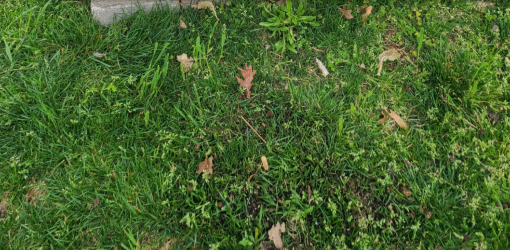Add water
Install the app
How to install the app on iOS
Follow along with the video below to see how to install our site as a web app on your home screen.
Note: This feature may not be available in some browsers.
You are using an out of date browser. It may not display this or other websites correctly.
You should upgrade or use an alternative browser.
You should upgrade or use an alternative browser.
Lawn Care Advice Thread
- Thread starter Cobrabit
- Start date
I gotta get my thatch down (st Augustine), so I have set my mower as low as it will go and did a pass last weekend. also have low patches that I think are from the slope of the yard washing out the dirt when it was sodded two years ago. Looks like craters in the yard.
Then have to replace 14 shrubs we lost in the freeze. GRRR.
I'm assuming you bagged the clippings. I'd recommend looking at the SunJoe dethatcher that Wizard talked about and can be seen in the YouTube videos by the Pest and Lawn Ginga. I've got a pull behind AgriFab for my John Deere, but if I had a yard less than 5k sq. ft., then I'd likely buy the SunJoe model. Seems to have good reviews and worth it if you dethatch each year with warm season grasses or KBG.
still a little skeptical because you wait 24 hours before you can water it in.
That's likely for the post-emergent to be absorbed through the leaves of the weeds. Then watering in after will help push the fertilizer and post-emergent into the soil where the microbes will break them down to feed the roots and provide a barrier for weeds respectively.
Most spray post-emergents are rain fast within a couple hours, but granules need to stick to the leaves for longer to be absorbed. The directions may even suggest to apply to a damp lawn either after rain or irrigation to help the post-emergent stick to the leaves.
fordman84
Administrator
- Joined
- Aug 13, 2020
- Posts
- 45,201
- Reaction score
- 82,364
- Bookie:
- $ 140,167.00
I'll have to look into it, but comb dethatchers can't be used on st Augustine. I could rent a plug aerator, but the thatch isn't that bad. I broke down and got a new mower this year after 17 years. It's the Toro super recycler but yes I did bag this first time and will the second as well. Took forever and I've always bagged in the past, hope not to have to with the recycler. I'm more likely to rent the machines I use once a year, let someone else maintain itI'm assuming you bagged the clippings. I'd recommend looking at the SunJoe dethatcher that Wizard talked about and can be seen in the YouTube videos by the Pest and Lawn Ginga. I've got a pull behind AgriFab for my John Deere, but if I had a hard less than 5k sq. ft., then I'd likely buy the SunJoe model. Seems to have good reviews and worth it if you dethatch each year with warm season grasses or KBG.
That's likely for the post-emergent to be absorbed through the leaves of the weeds. Then watering in after will help push the fertilizer and post-emergent into the soil where the microbes will break them down to feed the roots and provide a barrier for weeds respectively.
Most spray post-emergents are rain fast within a couple hours, but granules need to stick to the leaves for longer to be absorbed. The directions may even suggest to apply to a damp lawn either after rain or irrigation to help the post-emergent stick to the leaves.
I'll have to look into it, but comb dethatchers can't be used on st Augustine. I could rent a plug aerator, but the thatch isn't that bad. I broke down and got a new mower this year after 17 years. It's the Toro super recycler but yes I did bag this first time and will the second as well. Took forever and I've always bagged in the past, hope not to have to with the recycler. I'm more likely to rent the machines I use once a year, let someone else maintain it
if you don't have a large area and feel up to it, you can get a dethatching rake which may be gentler on St. Augustine than an electric dethatcher. Check out the Lawn Care Nut on YouTube that linked earlier. He's in FL and either has St. Augustine, Centipede, or Zoysiagrass, can't tenner which, but I'd imagine he has a video regarding detaching for St. Augustine somewhere.
fordman84
Administrator
- Joined
- Aug 13, 2020
- Posts
- 45,201
- Reaction score
- 82,364
- Bookie:
- $ 140,167.00
I have seen his stuff before but don't subscribe, I'll check it out. again. I've just always scalped st. Augustine every other year, before the runners start going crazy, but I'm sure there are better ways. I also say every year I'm going to do some of those soap+beer concoctions that are supposed to loosen soil, kill bugs, and help breakdown the thatch. Then I drink the beer and wash the car, forgetting why I initially had both in the driveway.if you don't have a large area and feel up to it, you can get a dethatching rake which may be gentler on St. Augustine than an electric dethatcher. Check out the Lawn Care Nut on YouTube that linked earlier. He's in FL and either has St. Augustine, Centipede, or Zoysiagrass, can't tenner which, but I'd imagine he has a video regarding detaching for St. Augustine somewhere.
I have seen his stuff before but don't subscribe, I'll check it out. again. I've just always scalped st. Augustine every other year, before the runners start going crazy, but I'm sure there are better ways. I also say every year I'm going to do some of those soap+beer concoctions that are supposed to loosen soil, kill bugs, and help breakdown the thatch. Then I drink the beer and wash the car, forgetting why I initially had both in the driveway.
I have no experience with warm grasses, outside of putting for birdie.....okay bogey.
No scalping of cool season grasses, since they do best 2.5-3.5 inches tall, while bermuda wants to be cut under 1 inch.
So while I'm learning about cool grasses now, the wife will eventually want to head to Orlando (Disney freak) when we retire, then it'll be a whole new ballgame.
fordman84
Administrator
- Joined
- Aug 13, 2020
- Posts
- 45,201
- Reaction score
- 82,364
- Bookie:
- $ 140,167.00
Just get st Augustine, Scotts turfbuilder (purple bag) and water 3x a week. Mow every weekend, and you are good to go. Tough enough for the heat, hardy enough for the shade, grows fast enough to take over the neighbors yards in 4 years.I have no experience with warm grasses, outside of putting for birdie.....okay bogey.
No scalping of cool season grasses, since they do best 2.5-3.5 inches tall, while bermuda wants to be cut under 1 inch.
So while I'm learning about cool grasses now, the wife will eventually want to head to Orlando (Disney freak) when we retire, then it'll be a whole new ballgame.
Just get st Augustine, Scotts turfbuilder (purple bag) and water 3x a week. Mow every weekend, and you are good to go. Tough enough for the heat, hardy enough for the shade, grows fast enough to take over the neighbors yards in 4 years.
I'm in the transition zone with a steep grade for 2/3rds of my property, oak trees, and plenty of dips/holes. Unlikely I'd go to a warm season grass that likes to be cut low.
There are homes in my area that have bermuda, but also small flat yards without much shade cover.
Overall, it is what it is and we all work with what we've got. May look forward to that retirement where winter lows are in the 50-60s
Not the lawn, but the wife had a thought this morning... you know how that goes. A trip to Lowe's and a few hours later, she's got her flowers and a small garden on the deck with from right to left strawberries, bell peppers, two types of tomatoes, jalapeños, broccoli, and romaine.
Looks like a little rain this afternoon is on its way so fished just in time to get my pork out of the smoker and the burgers, chicken, and Mac and cheese will be out shortly. Time for a beer!
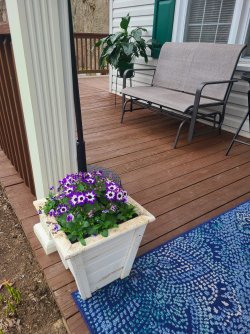
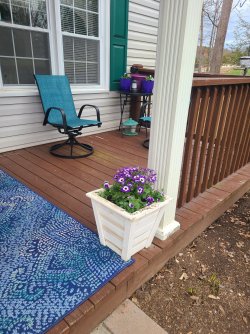
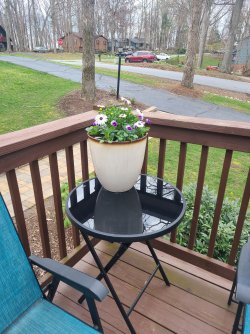

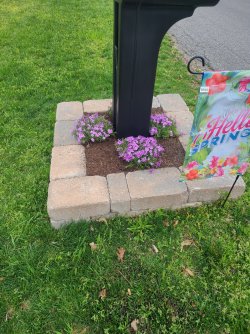
Looks like a little rain this afternoon is on its way so fished just in time to get my pork out of the smoker and the burgers, chicken, and Mac and cheese will be out shortly. Time for a beer!





- Joined
- Aug 19, 2020
- Posts
- 6,170
- Reaction score
- 10,385
- Bookie:
- $ 3,848.00
In that last image we can see a lot of short seed heads. I'm assuming it's all Poa Annua. If so, that's going to be a fun patch to eradicate.Not the lawn, but the wife had a thought this morning... you know how that goes. A trip to Lowe's and a few hours later, she's got her flowers and a small garden on the deck with from right to left strawberries, bell peppers, two types of tomatoes, jalapeños, broccoli, and romaine.
Looks like a little rain this afternoon is on its way so fished just in time to get my pork out of the smoker and the burgers, chicken, and Mac and cheese will be out shortly. Time for a beer!
View attachment 25130View attachment 25131View attachment 25132View attachment 25133View attachment 25134
I had a small area (maybe 4ft x 5ft) that was that prevalent 2 years ago. As that area is near trees I really didn't want to glyphosate it off. Really didn't want to use anything harsher than tenacity which does little more than make it sick and easier to hand rake out to clear room for over seeding. I have zero seed heads in that area as of now, but it's still too cold here to declare victory. I expect something when we reach above 55degrees soil temp.
My plan was to thicken up the area with good grass and then put a preventer down this fall. The real bitch of poa is you can't both put down new grass seed to thicken up the area and also put a preemergent down to stop poa from germinating at the same time. You have to choose one or the other.
Worse, it's such a pain to have to bag mow the infected areas and to them last (or clean before moving to normal areas) to limit seed spread. Had I not been lazy a few years and fought it when it started to take foothold I wouldn't have had this mess.
Do you know what the thicker blades are? Both the straight ones and that clumped one by the bricks? Just curious. Tenacity will for sure work on the little stuff around that flag. That clump will probably fall as well, not sure about the thick grassy stuff, depends on what it is.
Love the diversity in the background. Some of that straight lighter green with the dark green. I like a good climax lawn though, not everyone does. I'm trying to blend mine more this year, but not eliminate it. Even the small amount of over seed I've done this spring was a mix of black beauty ultra and rye. Maybe 4-1.
In that last image we can see a lot of short seed heads. I'm assuming it's all Poa Annua. If so, that's going to be a fun patch to eradicate.
I had a small area (maybe 4ft x 5ft) that was that prevalent 2 years ago. As that area is near trees I really didn't want to glyphosate it off. Really didn't want to use anything harsher than tenacity which does little more than make it sick and easier to hand rake out to clear room for over seeding. I have zero seed heads in that area as of now, but it's still too cold here to declare victory. I expect something when we reach above 55degrees soil temp.
My plan was to thicken up the area with good grass and then put a preventer down this fall. The real bitch of poa is you can't both put down new grass seed to thicken up the area and also put a preemergent down to stop poa from germinating at the same time. You have to choose one or the other.
Worse, it's such a pain to have to bag mow the infected areas and to them last (or clean before moving to normal areas) to limit seed spread. Had I not been lazy a few years and fought it when it started to take foothold I wouldn't have had this mess.
Do you know what the thicker blades are? Both the straight ones and that clumped one by the bricks? Just curious. Tenacity will for sure work on the little stuff around that flag. That clump will probably fall as well, not sure about the thick grassy stuff, depends on what it is.
Love the diversity in the background. Some of that straight lighter green with the dark green. I like a good climax lawn though, not everyone does. I'm trying to blend mine more this year, but not eliminate it. Even the small amount of over seed I've done this spring was a mix of black beauty ultra and rye. Maybe 4-1.
There is definitely POA there and on the other side of the driveway. I'm on a corner lot and get the rain runoff coming from my neighbors down the side of the road before turning 90 degrees going down the ditch, then into my backyard, before filtering down into a drain in my other neighbor's yard. That area doesn't drain well, so it'll be hard to ever control POA there. While I do plan to overseed in the fall (black beauty ultra is being delivered today), I'll likely skip these areas and hit them with preemergent to see if that helps next year.
Plenty of other broad leaf weeds in that picture, along with wheat from straw I put down in the fall to help keep seed from moving too much in the rain, which is likely some of that straight blades you're seeing. The wheat will eventually die out this summer if I keep it mowed. I did hit the lawn with a bottle of spectracide weed stop Saturday morning about 4 hours before the rain, so we'll see how that did over this next week. What doesn't die back will likely get a spray of tenacity when I have more time.
Always a process.
Last edited:
You guys certainly know a lot about grasses. What is recommended for a shady area under a tree? I have mostly tall fescue which does poorly without much sun.
You guys certainly know a lot about grasses. What is recommended for a shady area under a tree? I have mostly tall fescue which does poorly without much sun.
You're going to have difficulty growing much in that situation, but fine fescue and red creeping fescue are probably your best bet. You can find them in most dense shade mixes at any big box store (Scott's, Pennington, etc). It won't grow as fast and the blades will be thinner/ finer, but could do okay in the shade.
I haven't tried the Jonathan Green shady nooks mix, but from what I've read is that if it won't grow in the shade, then nothing will.
Another issue you may have is the tree roots are probably going to suck up much of the water you're putting down, so you'll need to keep an eye on it to see if you need to add some.
If you've got a lot of shade cover, you could also consider trimming the tree or raising the canopy to allow more light and air circulation.
You're going to have difficulty growing much in that situation, but fine fescue and red creeping fescue are probably your best bet. You can find them in most dense shade mixes at any big box store (Scott's, Pennington, etc). It won't grow as fast and the blades will be thinner/ finer, but could do okay in the shade.
I haven't tried the Jonathan Green shady nooks mix, but from what I've read is that if it won't grow in the shade, then nothing will.
Another issue you may have is the tree roots are probably going to suck up much of the water you're putting down, so you'll need to keep an eye on it to see if you need to add some.
If you've got a lot of shade cover, you could also consider trimming the tree or raising the canopy to allow more light and air circulation.
Good info, thanks. The "experts" I buy fertilizers from at Lawn Depot say that it's better to seed in the fall since seeds don't germinate till early May and root growth ceases in mid-summer. That may be true but it seems like I could still get some grass going by May-June, but no weed control.
Good info, thanks. The "experts" I buy fertilizers from at Lawn Depot say that it's better to seed in the fall since seeds don't germinate till early May and root growth ceases in mid-summer. That may be true but it seems like I could still get some grass going by May-June, but no weed control.
Fall is the best time to seed cool season grasses like fescue. Soil temps are still warm with rain and lower heat and less competition from weeds.
You can seed in the spring and they'll begin to germinate when the soil temperatures get above 55 degrees, which is typically when the air temperature stays above 65. The issue with seeding in the spring is you can't put down pre-emergent for the crabgrass, which is also germinating at the same temperatures. The seedlings will come up nice and pretty, but won't have time to mature enough and store enough energy in their roots to survive a hot/dry summer. You can do it to fill in some really bare spots, but be prepared to seed that same area again in the fall when most of it dies off.
- Joined
- Aug 19, 2020
- Posts
- 6,170
- Reaction score
- 10,385
- Bookie:
- $ 3,848.00
Grass is at its peak growing in spring. You can fill in, top seed, or do full renovation in the spring and it will grow. Especially faster growing seeds like rye and turf type tall fescue.Good info, thanks. The "experts" I buy fertilizers from at Lawn Depot say that it's better to seed in the fall since seeds don't germinate till early May and root growth ceases in mid-summer. That may be true but it seems like I could still get some grass going by May-June, but no weed control.
The reason fall is the more preferred time is the young grass will generally survive better in their first dormant winter than spring plants will fare during their first hot summer. Species like Kentucky blue grass that take a long time to mature will suffer more early on because of it.
The other reason is weed control. It is best to do aeration, dethatching, and scarifying in the fall when disturbing weed seeds is less impactful.
You will be fighting more weeds with any of those activities in the spring.
Doesn't mean you can't do spring cleanup or planting. You just have to understand what comes with it.
I won't be able to put full preemergent down this spring because of some over seeding I'm doing as part of my two year project.
I know what that means and I'm good with it.
Grass is at its peak growing in spring. You can fill in, top seed, or do full renovation in the spring and it will grow. Especially faster growing seeds like rye and turf type tall fescue.
The reason fall is the more preferred time is the young grass will generally survive better in their first dormant winter than spring plants will fare during their first hot summer. Species like Kentucky blue grass that take a long time to mature will suffer more early on because of it.
The other reason is weed control. It is best to do aeration, dethatching, and scarifying in the fall when disturbing weed seeds is less impactful.
You will be fighting more weeds with any of those activities in the spring.
Doesn't mean you can't do spring cleanup or planting. You just have to understand what comes with it.
I won't be able to put full preemergent down this spring because of some over seeding I'm doing as part of my two year project.
I know what that means and I'm good with it.
Guess you're right. Just read that preemergent herbicides don't actually kill weed seeds before germination. Instead, they fatally interrupt their growth process in some way to prevent the seed from getting all the way through the seed germination stage.
Guess you're right. Just read that preemergent herbicides don't actually kill weed seeds before germination. Instead, they fatally interrupt their growth process in some way to prevent the seed from getting all the way through the seed germination stage.
This is why we have to put pre-emergent down every year to create a barrier for any dormant seeds from years prior that decide to germinate. If it could kill the seed, we'd likely only have to do it once or twice and they'd never germinate.
There are some pre-emergents that you can use while seeding in the spring that will give your grass seedlings a head start over weeds, but they don't last that long and are more expensive. Mesotrione is the active ingredient in Tenacity and Scott's that will give you about a month of protection, but crabgrass and other weeds germinate for several months that will compete with new grass.

Scotts® Turf Builder® Triple Action Built For Seeding
Scotts® Turf Builder® Triple Action Built For Seeding is formulated to help grow new grass and control against weeds while feeding and strengthening grass. Now you don't have to choose how to best care for your lawn—you can maximize growth with one application.
- Joined
- Aug 17, 2020
- Posts
- 13,216
- Reaction score
- 29,461
- Bookie:
- $ 500.00
Mostly fall germinating weeds (poa annua, chickweed, hairy bittercrest, wheat that sprouted from straw covering the overseed, etc) that I've sprayed with 2, 4D recently and should die off soon. Since I aerated and seeded in the fall, I didn't put down pre-emergent and the core aeration likely brought up some extra weed seeds as well.
I'm not worried about them, as the goal was to overseed with Black Beauty Ultra (TTTF, perennial rye, and KBG) to start thickening up a rather thin and neglected yard. That grass is starting to grow pretty good now that temps are getting warmer and I'm going to push plenty of nitrogen this spring.
Plan to do another overseed this fall, so I'll once again deal with the fall/early spring weeds next year, but then should be able to have a decent stand of grass to work on applying pre-emergents in both the spring and fall for the next few years before I may want to overseed again.I
I'm not worried about them, as the goal was to overseed with Black Beauty Ultra (TTTF, perennial rye, and KBG) to start thickening up a rather thin and neglected yard. That grass is starting to grow pretty good now that temps are getting warmer and I'm going to push plenty of nitrogen this spring.
Plan to do another overseed this fall, so I'll once again deal with the fall/early spring weeds next year, but then should be able to have a decent stand of grass to work on applying pre-emergents in both the spring and fall for the next few years before I may want to overseed again.I

